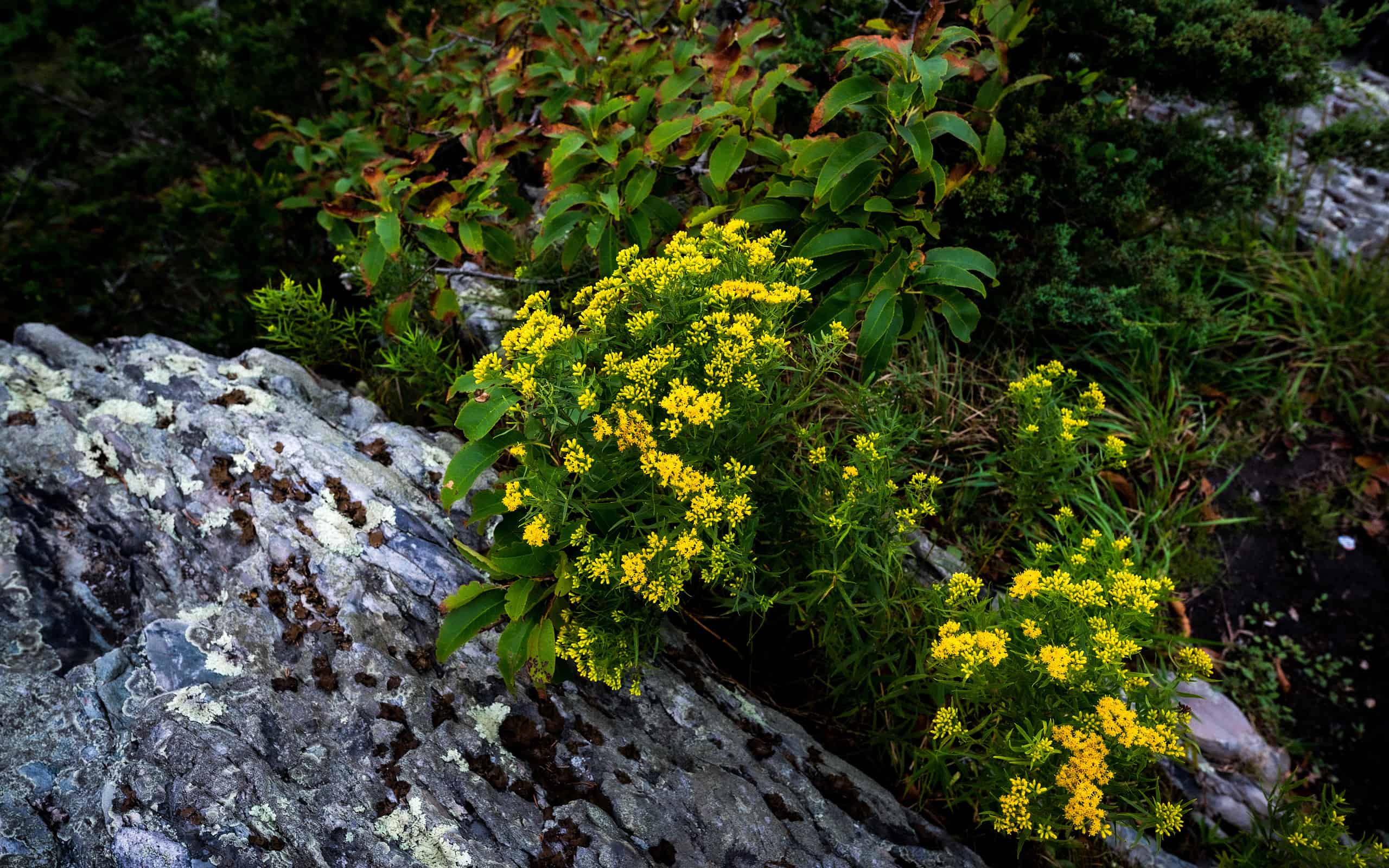Perennial wildflowers are those that come back every year, sometimes for decades. There are people who even consider some of them to be weeds. Yet many of these perennial wildflowers are beautiful enough for people to want them in their gardens. Here are nine of them.
1. Poppies

This Oriental poppy hybrid has the diagnostic dark blotch at the base of the petals.
©Ole Schoener/Shutterstock.com
These flowers of the Papaver genus come every year and delight with their tissue thin petals and colors of yellow, orange, orange-red, red, and white. The Oriental poppy is perennial, and it blooms in late spring to early summer. The plant grows from 2 to 3 feet high, and the leaves are hairy and gray green. The flower of the parent species is deep red with a blotch of black at the base of each petal, but hybrids come in many colors. Poppies aren’t particular about soil as long as it’s well-drained and deep enough to accommodate their long roots. They do best in full sun.
2. Queen Anne’s Lace
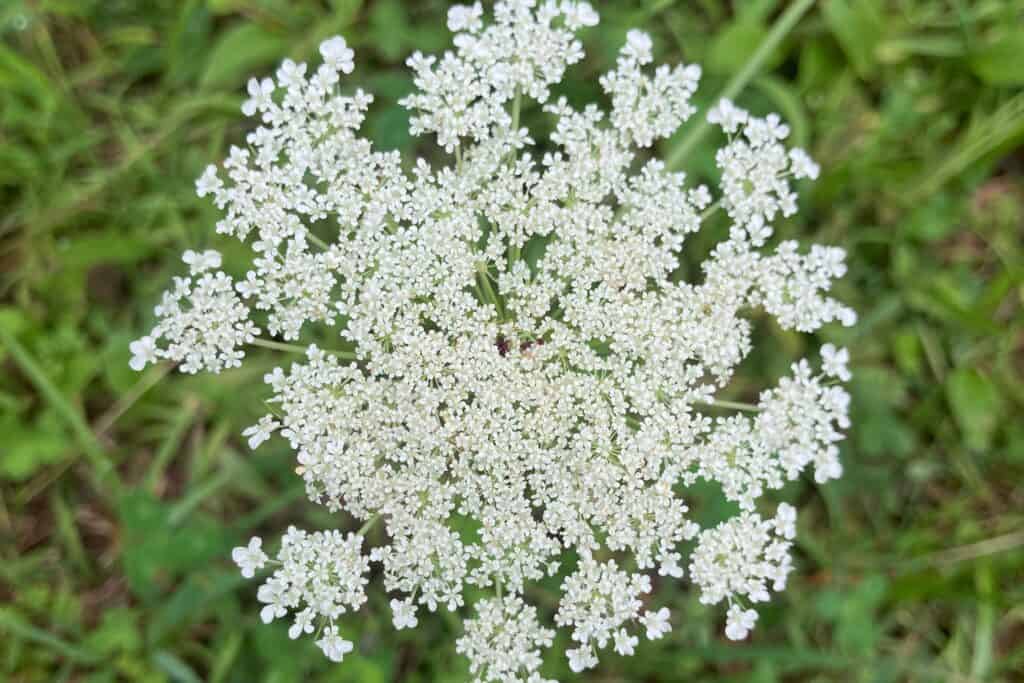
Queen Anne’s lace is also called wild carrot.
©Lake Erie Gal/Shutterstock.com
This flower is sometimes considered a weed and is often seen in abandoned places and along the side of the road. Still, it’s so pretty that it really belongs in your garden. It has delicate, fernlike leaves, and its flat head bears tiny white flowers that really do look like lace. It’s also a food and host plant for a variety of butterflies and moths.
Basically, Queen Anne’s lace is a type of carrot, and its scientific name is Daucus carota. Some people eat the root with relish, while it causes digestive upsets in others. It is vitally important to not mistake Queen Anne’s lace and poison hemlock. Poison hemlock is deadly if it’s eaten. One way to tell is the smell. Queen Anne’s lace smells like a carrot while poison hemlock has a smell that’s off-putting. It also grows much taller than Queen Anne’s lace. It can grow to 8 feet.
Queen Anne’s lace grows between 1 and 4 feet tall. Not only is it not particular about soil, but it can withstand periods of drought and heat that can defeat other plants. It doesn’t even mind severe winters. However, the plant seems to avoid damp places.
Though a place in the garden full of Queen Anne’s lace is beautiful, you do need to remember that it’s very aggressive and can grow where soil is poor and sunlight is scarce. To prevent this, deadhead the plant before it can produce seeds. If the plant’s already escaped its bounds, dig out the taproot.
3. Oxeye Daisy
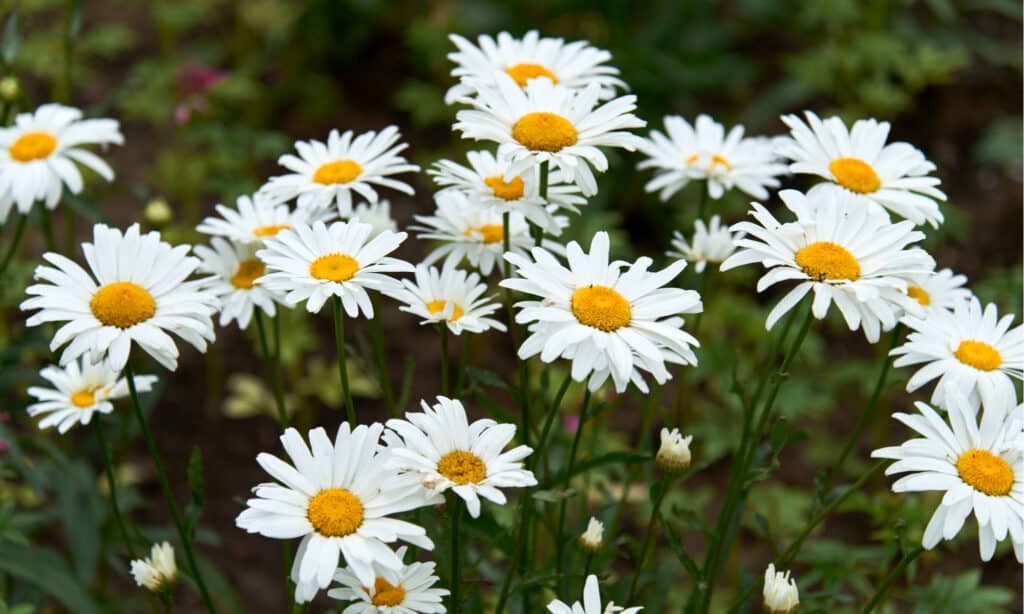
Oxeye daisies are tough plants despite their sweet looks.
©Smyshliaeva Oksana/Shutterstock.com
This flower, Leucanthemum vulgare comes back year after year, blossoms from May to August, and is cherished for its pure white ray petals surrounding a sunny yellow center. The plants have oval, toothed leaves at the base and grow from 1 to 3 feet high with a 1 to 2 foot spread. Oxeye daisies prefer full sun, and soil that’s dry to medium. Despite its sweet looks, the plant is tough and can stand deer and drought. It can even be a bit invasive. To keep the plant blooming, deadhead spent flowers. To keep it tidy, divide the clumps every two to three years.
The oxeye daisy is actually native to Europe but is found in most places in North America, and thrives in hardiness zones 3 to 9. It’s not only a great garden plant but is excellent for flower arrangements, as the flowers last for a long time.
4. Goldenrod

The tiny, daisy-like flowers of the goldenrod are always female. Other types of flowers on the plant are male, hermaphrodite or infertile.
©iStock.com/aga7ta
There are over 100 species in the Solidago genus, and all of them are perennial. Most of them are North American natives, and they’re sometimes considered weeds because they’ll grow in a variety of habitats and spread through rhizomes. Goldenrods can be low to the ground or grow to 7 feet tall with a 6 foot spread. Their stems and leaves can be hairy or fuzzy, and the leaves usually have even margins but some are toothed. The flowers come in panicles and can resemble tiny daisies, or discs. The daisy-like flowers are always female while the others are male, both male and female, or infertile. Whatever the species, the goldenrod is known for its bright yellow flowers that come in late summer or even in the fall. Some goldenrods produce nectar in such amounts that they attract clouds of pollinators, including bees, butterflies, and wasps.
Goldenrods do well in full sun to part shade and like their soil to be a little acidic and somewhat rich and wet, though well-drained. Some species can stand spring flooding. The plant spreads through seeds as well as rhizomes, so if you don’t want your goldenrod to be invasive, remove the flowers before they go to seed. Before the plant blooms it grows rather uninspiring stalks of green leaves, but for many gardeners it’s worth waiting for the flowers. Also, goldenrods don’t cause hay fever, for their pollen is too heavy to be carried on the wind and into the nasal passages.
5. Toadflax
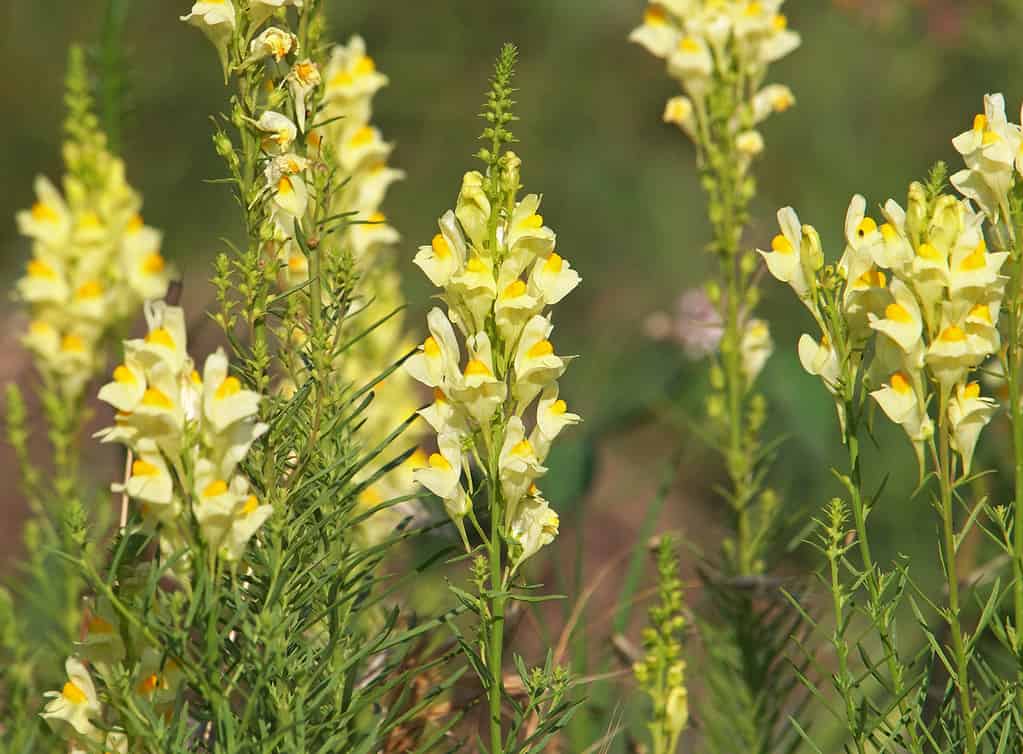
Another name for this plant that returns every year is butter and eggs.
©iStock.com/emilio100
Lunaria vulgaris, or common toadflax is another wildflower that comes back every year. Though it’s native to Eurasia, it’s now a common plant in North America. The plant grows between 6 and 35 inches high and has long, narrow, glaucous leaves. People prize toadflax in the garden for its beautiful flowers, which are pale yellow and orange, giving it its name of butter-and-eggs. They’re found at the top of the plant, whose blooming time lasts from the middle of summer to the middle of autumn. Eventually, the flowers give way to a round capsule full of small seeds.
The flower has an underlip that keeps it mostly shut, so it takes determined insects such as bumblebees to open it up and reach the pollen and nectar. It also makes a snapping sound when the bottom of the corolla is squeezed. In some places common toadflax is considered a weed. It can thrive in different conditions, as long as the soil drains well and the plant gets a good amount of sunlight. Toadflax can also be grown indoors, and its long-lasting flowers are good for floral arrangements.
6. Michaelmas Daisy
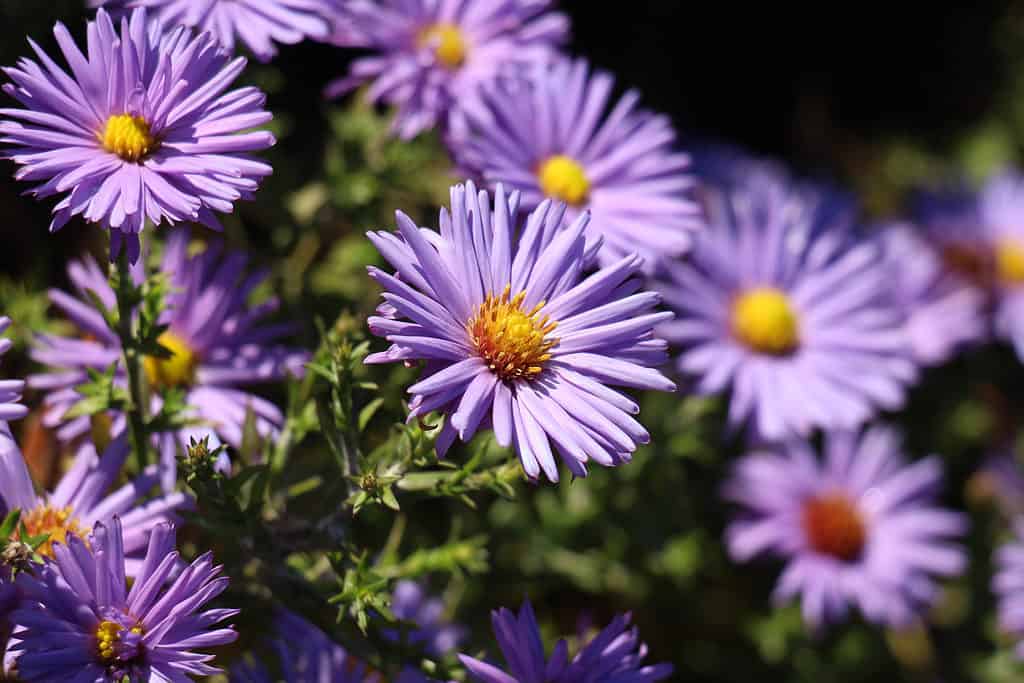
The Michaelmas daisy is a type of aster, and it has purple petals and golden centers.
©Elenkina/Shutterstock.com
Asters are plants with daisy-like flowers. They’re famous for blooming in late summer or even early fall after other flowering plants have gone to seed. Indeed, one type of aster, the Michaelmas daisy, gets its name because it blooms around the feast day of Michael the archangel, which is September 29 in the Western rite and November 8 in the Eastern rite.
The Aster genus used to contain hundreds of species but advanced technologies have moved most of these species to other genera. A number of asters have been moved to the Eurybia and Symphyotrichum genera. The Michaelmas daisy is a flower that belongs to the Symphyotrichum genus, and its scientific name is S. novae-angliae.
This perennial flower presents with rays that are usually purple but can also be pink or white. They surround a small disk. The plant grows between 1 and 4 feet tall, though plants have been known to grow 6 feet tall. It usually has a 2 to 3 foot spread. The Michaelmas daisy grows in clumps and has hairy, unbranched stems gripped by lanceolate leaves. This aster likes to grow in wet environments and can tolerate clayey soil. It does best in full sun, and you may need to pinch it back a bit to make sure air can circulate through the plant and it won’t grow so leggy that it will need to be staked.
7. Japanese Honeysuckle
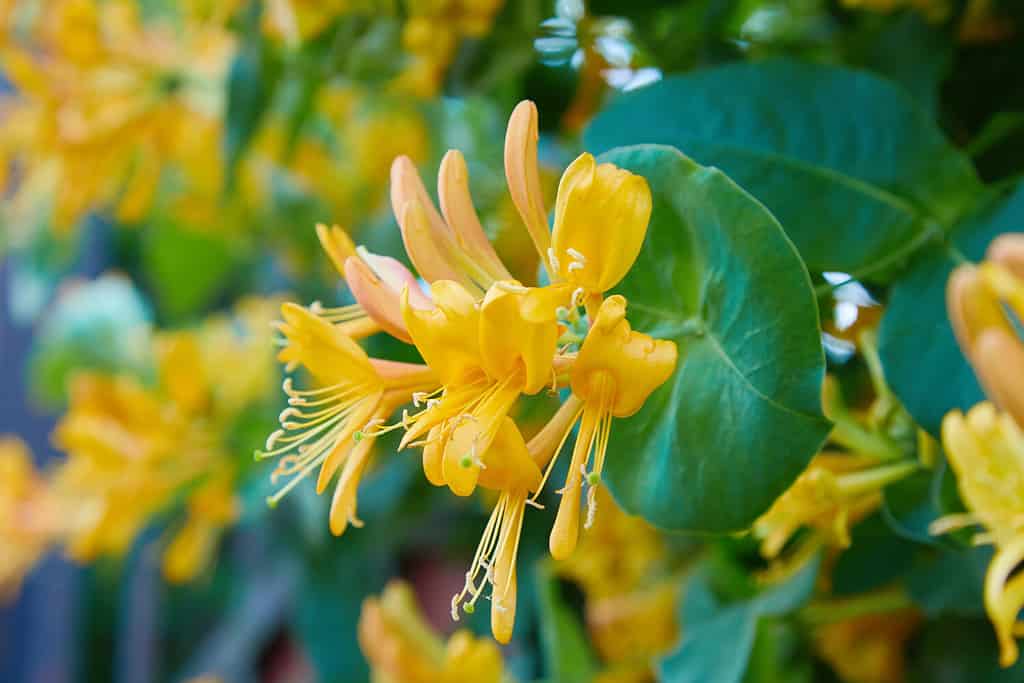
Even though it can be unruly, the Japanese honeysuckle is prized for its beautiful flowers and heavenly fragrance.
©krolya25/Shutterstock.com
Native to east Asia, this vine whose fragrant flowers come back every year is now very much at home in North America. Like a number of wildflowers mentioned, it’s considered a weed in some places. But for some gardeners, its unruliness is worth it just for the beauty and sweet smell of its flowers.
The Japanese honeysuckle, Lonicera japonica is a climbing vine. It climbs 33 feet or higher in trees, around decks or up the sides of houses, though there are cultivars used as a ground cover. It has oval leaves, and the young stems are reddish and fuzzy. As the plant ages, they grow woody. At first the flowers are creamy white, then turn butter yellow. They attract a host of pollinators, including bees and hummingbirds. Rabbits and deer eat the flowers. By autumn, the flowers give way to black berries. Though the nectar is safe for humans, the rest of the plant is poisonous.
8. Carolina Jessamine
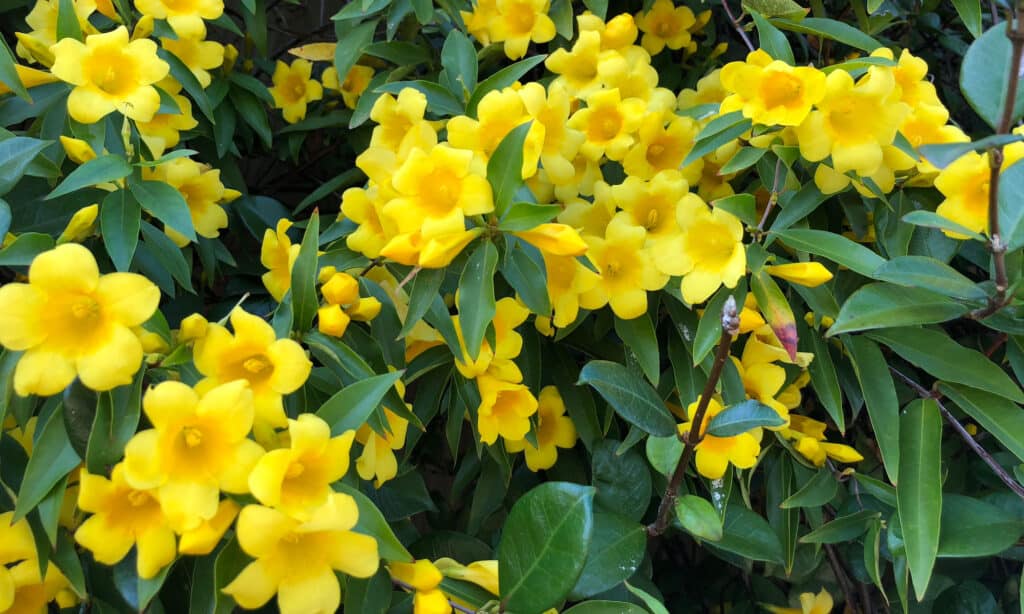
In some places in the south, this perennial plant blooms as early as January.
©iStock.com/Campwillowlake
This perennial wildflower is the state flower of South Carolina and is a harbinger of the end of winter. It can flower as early as late winter, and its funnel shaped, butter yellow flowers have a smell like hot, sweet candy. The Carolina jessamine isn’t a real jasmine but belongs to the Gelsemium genus.
The Carolina jessamine can grow from 10 to 20 feet high in trees, the roof over a porch, pergolas or trellises, and is an evergreen. The glossy, dark green leaves are lance-shaped and grow between 2 and 4 inches long. The flowers arrive in clusters, and some have orange throats. Unlike the honeysuckle, no part of the Carolina jessamine should be eaten, for the plant is full of a poison related to strychnine. This toxin kills livestock and even kills honeybees, though bumblebees are immune.
Carolina jessamine does best in full sun and rich, well-draining soil with medium watering. In many places, the vine is simply a volunteer and succeeds without particular care.
9. Common Blue Violet
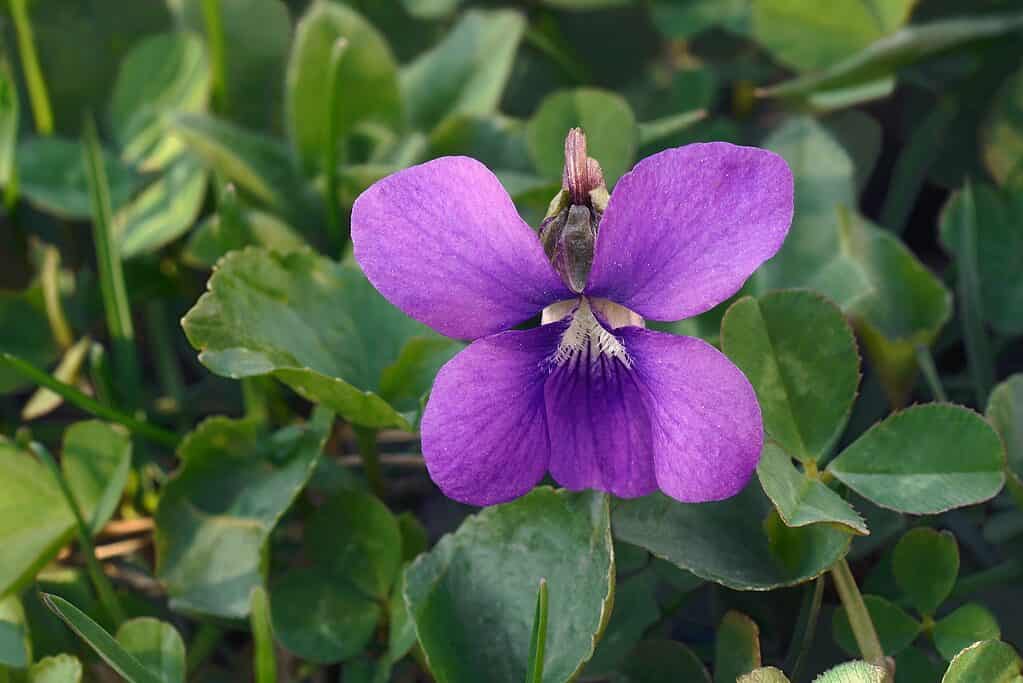
The common blue violet (Viola sororia) is edible.
©Nikolay Kurzenko/Shutterstock.com
The humble, common blue violet Viola sororia is native to the eastern part of North America. A wildflower that reliably comes back every year, it happily self seeds in gardens to the point where some people consider it a weed. Yet, if you can guide it, it’s just the thing for a shady part of your garden, as long as the soil is well-drained. It flourishes in clayey, loamy or even sandy soil and can tolerate a pH from acid to neutral to alkaline.
The violet grows 6 to 10 inches tall and is as wide as it’s tall. Its leaves are glossy green and heart-shaped, and the flowers are usually purple with white throats, but there are plants whose flowers are white or blue. The flowers arrive from April to August, and the stems holding the flower droop modestly. Butterflies, especially the fritillaries, use the common violet as a host plant, and the flowers are visited by pollinators such as mining bees, which specialize in violets. One interesting aspect of the common violet is how it reproduces. Though it produces seeds from pollination, it also self-fertilizes. This is called cleistogamy. This happens in late summer and eventually the seed capsules turn around in the plant, open up and shoot out seeds as far as 9 feet. Violets also use ants to carry their seeds to germinate a distance from the parent plant.
Unlike honeysuckle and Carolina jessamine, the violet is edible. It’s even sugared and placed on cakes and cookies as decoration.
Thank you for reading! Have some feedback for us? Contact the AZ Animals editorial team.

